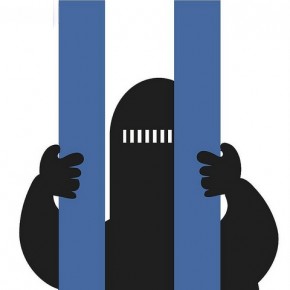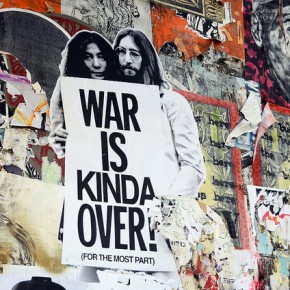When I heard about the rampage in Isla Vista — in which a deranged narcissist unleashed a nightmare on the slightly fallen student paradise beside the University of California, Santa Barbara—I was in Washington, DC attending symposia on Ralph Ellison. Now, back at UCSB, wrapping up the quarter with my writing students, I think I finally understand the ending of Invisible Man.
2014 is the centennial of Ellison’s birth. In conjunction with the American Literature Association’s annual Memorial Day weekend meeting, being held this year in DC, the Ralph Ellison Society was sponsoring several events commemorating the occasion. The centerpiece — and the primary reason for my journey — was a special meeting in the Library of Congress’s little-known Ellison Reading Room, one of three such rooms in the historic Jefferson Building, which preserve the personal book collections of a handful of major cultural figures (the other rooms belong to President Woodrow Wilson and Oliver Wendell Holmes). This was to be my first visit to the Ellison Room, although not my first trip to the Library, which also houses Ellison’s manuscripts and personal papers.
But boarding the plane, three days before the violence broke out near UCSB, wasn’t simple for me. In fact the trip had been a source of anxiety, which I couldn’t easily explain. It wasn’t professional nerves. I have presented to the Society several times in the past, and have always found its members receptive to junior scholars and new ideas. Generally, I feel more comfortable speaking with other academics about Ellison than almost any other writer: he is the central figure in the dissertation I finished a year ago, on how the idea of “writer’s block” shapes perceptions of politically challenging authors in American culture.
Yet for weeks, I hadn’t been able to write the paper I was meant to give. Driving down the Pacific Coast Highway to LAX to catch my flight, I had an ocular migraine: blind spots in my vision, which I experience rarely, and only during times of extreme stress. I had to pull off the road in Malibu. I wish I could say I was somehow sensing the escalation in Elliot Rodger’s virginal rage fifty miles up the coast, back in Santa Barbara. But I now believe my anxiety about returning to Ellison after a year-or-so hiatus, and for the first time since beginning my job teaching in UCSB’s interdisciplinary Writing Program, was actually part of a response to a larger, more insidious cultural problem: a problem in which both Rodgers and Ellison — and now me, and my students and colleagues as well — are all implicated.
Shadows present, in short. But shadows of what? At the time, it was all very murky to me, but the Isla Vista shootings made it clear. Working with Ellison again, the bewildering nature of American reality — and how writers and artists respond and fail to respond to that reality — would have been very much on my mind. Famously, Ellison never managed to finish the novel he planned as a follow-up to Invisible Man (1952), a novel about a racially-charged political assassination on the floor of the Senate. There is no single explanation for why Ellison didn’t finish, but one factor many observers have noted is that — regardless of how this specifically impacted Ellison’s process — the history of the Civil Rights movement, and the string of high-profile assassinations during the 1960s and 1970s, basically wrote his novel for him.
After the killings, I sought to help my students make sense of things, and I thought of Philip Roth, who — since at least The Human Stain (2000), and maybe since Portnoy’s Complaint (1969) — has been among the greatest commentators on the logic of American spectacle. Specifically, I thought of the essay Roth wrote in 1960, “Writing American Fiction,” which responds to a variety of media events, including the first televised presidential debates. Here is Roth, for whom the problem of understanding the relationship of American fiction and American reality is “simply this: that the American writer. . .has his hands full in trying to understand, describe, and then make credible so much of American reality. It stupefies, it sickens, it infuriates, and finally it is even a kind of embarrassment to one’s one meager imagination. The actuality is continually outdoing our talents, and the culture tosses up figures almost daily that are the envy of any novelist.”
No realistic novelist could have thought up a Lee Harvey Oswald, let alone imagined the uncanny plot in which the supposed Kennedy assassin would himself be shot and killed live on national television. Whether or not that’s a direct reason why Ellison, writing his own assassination novel, never felt a sense of urgency to finish and publish his book, it might as well have been. Similarly, no realistic novelist could have written an Elliot Rodger, or the plot in which the alienated son of a Hollywood producer – one who worked on The Hunger Games, no less — would write out a 140-page manifesto, upload a chillingly serious farewell to the universe on YouTube, and then attempt to carry out his misogynistic revenge against a campus already reeling from a year marred by several instances of sexual violence. For a place engaged in an incendiary, ongoing debate about rape culture and the possible implementation of “trigger-warnings” on course syllabi, Rodger overloads the realistic imagination.
Upon my return to Santa Barbara, I watched and did my best to help my disbelieving students grapple with the awful symbolism of Rodger’s plan, as well as with legitimate psychological trauma. Isla Vista is a tiny area, and more than one of my students witnessed the violence first-hand. None were physically harmed, thankfully, but more than one dodged gunfire. And the question for us became exactly what it had been for Roth, and perhaps for Ellison as well: the question of how and just as importantly why to go on. This was the case especially in my upper-division “Writing for the Health Professions” course, where there was extra resonance between the Isla Vista events and our course material. In the wake of Rodger’s rampage, could our work — thinking both philosophically and practically about how to become more humane doctors, nurses, and medical researchers — still mean anything at all? Medicine, on a long enough timeline, is always a losing battle, and I believe we wished to collectively evade how the killings uncomfortably called attention to the ultimate futility of all humanistic endeavor and the mission of the university more generally. Distracted, enervated, many of my students, and at times myself, felt like giving up the quarter altogether.
We needed an outlet, and my impulse was to give students an opportunity to write about the tragedy in a reflective essay, one which would supplement or, with permission, take the place of final papers. Several students took me up on the possibility. At the very least, the alternate assignment seemed to offer a kind of therapeutic outlet. But I remained — I remain — uneasy. If Roth is correct, then American “reality” — if such a word even applies to the phenomenon by which events occur and are understood by the American people in the twenty-first century — will always out-write the American novelist (which may be the reason why, in 2012, Roth announced his retirement from writing novels after one of the longest and more productive runs in all of American literature). I seriously wonder if my students, or anyone who attempts to respond to such an event, can escape its shaking cultural resonance, let alone understand the role of hair-trigger media networks in prompting and propagating the violence. In fact I worry that writing in response to such an event, or despite it, or against it –including the present article — resolves nothing. Or worse: that to pay attention to the violence, even privately, is to participate in its demented author’s plan.
The Ellison Reading Room is a bright, ornate alcove on the Jefferson Building’s first floor. At the end of the long, narrow space, lined with all of Ellison’s books, a window opens onto an unobstructed view of the US Capitol. On Thursday morning, the day before the killings — around the time Elliot Rodger might have been waking up to decide which Santa Barbara area beach to contaminate with his now infamous video — a group of a dozen or so Ellison friends and aficionados gathered to reevaluate Ellison and his work in our time. The group included Ellison’s cousin Muriel Morisey, Ellison’s friend and literary executer John Callahan, as well as several distinguished Ellison scholars. For two hours, we sat around a conference table, collectively resisting the urge to crane our necks for a glimpse of the titles Ellison might have been reading in his library.
Our conversations ranged widely. But many of them addressed Three Days Before the Shooting, which is the edition of Ellison’s unfinished second novel manuscripts Callahan and Adam Bradley coedited and released in 2010 (both were in attendance at the Library). Ellison left thousands of pages of draft materials and computer files behind at the time of his death in 1994. These materials center on the story of a race-baiting Senator from a northern state, who is, not insignificantly, actually black and passing. His racially-charged assassination on the floor of the US Senate forms the core event of the manuscripts, although the novel’s plot is incomplete. Our group of approached the problem with restraint. Not knowing Ellison’s full intentions, we sought to deal with the manuscripts as they existed rather than speculate on “why” Ellison was unable to complete his second novel. With the vessel of the messy, always incomplete American democracy looming in the background of our conversation — the very site of the shooting Ellison could not fully imagine in his messy, incomplete novel — we took his until recently unpublished efforts as seriously as they have ever been taken.
Before the Isla Vista killings, when I had my strange Malibu migraine, I believed I sensed subconsciously the meaning of my return to Ellison, and the importance of thinking about his chaotic brilliance now. In the wake of the tragedy, I am still mapping out how Ellison might be connected, but I think I have an idea. In one sense, the symposium was an academic activity of the most isolated kind. We were a group of specialized scholars in a closed meeting, thinking through the unpublished writings of a canonical American author. Beyond what we all would take away from the meeting personally, as teachers and writers, the symposium was admittedly an intellectual indulgence. But there is something symbolic, or at least neatly resonant, that our conversation was taking place inside a facility designed to house the research wing of the US Congress, and that it largely addressed a novel with epic ambitions, set in the same branch of government. For this reason, I think it’s worth noting the attention we were willing to pay Ellison’s incomplete work, to his uncompromising and at times maddening attempt to understand and allegorize American reality for four decades.
The book is unfinished in every way; the senator never even actually dies in the drafts, the various sections of the novel are not sutured together, and Ellison only published fragments from the novel during his lifetime. Yet it remains partially legible, and the process of reading it in its messy incompleteness — whether in the archives themselves, or via the lens of Three Days Before the Shooting, which is a simulated archive — is an exercise in extending Ellison’s work, and in trying to imagine what he could not imagine. As Adam Bradley put it at the symposium, reading Ellison’s manuscripts are a little like reading a Choose-Your-Own-Adventure novel, albeit one with almost infinite permutations, and significant political and philosophical consequences.
The very opposite, in other words, of reading Elliot Rodger’s manifesto, which has but one meaning: witness my irrational expression of my frustration, and thus empower me. Rodger and Ralph Ellison represent two utterly different American literary fates. Rodger knew that all he needed to do to publish and widely distribute his manifesto was to kill enough students to make the news, thus writing his crass entry into the diverse and ever-expanding canon of American mass murder. Ellison, on the other hand, in seeking to write a sweeping allegory on the paradoxes of identity and the meaning of symbolic violence in an American context, became something like his own Invisible Man. He retreated underground, into a long, unfinished, and probably unfinishable writing project, which he wrote not in pursuit of power, but in pursuit of incomplete cultural truth and understanding (although his post-Invisible Man essays offer additional insight into Ellison’s vision). Rodger sought only to speak for himself, and, insofar as his crude message was heard, succeeded. Ellison sought to speak for everyone, knowing full well that it was only possible to do so “on the lower frequencies,” in partial failure.
Perhaps when waged against evil genius, listening in on such frequencies, despite the inevitable isolation of the task, constitutes a political act?
On the sunny morning of Saturday, May 24 — the day after the killings, although I had not yet heard the news — I woke up at 5:30 in my hotel on New Jersey Avenue, put on my running shoes, and jogged to the Lincoln Memorial. I hadn’t been to the monument since I was in junior high school. A miracle on Memorial Day weekend in DC: I had the place to myself, aside from a disinterested guard. I took the peace and solitude as an occasion to reread Lincoln’s second inaugural address, which flanks the statue of the President on the right wall of the temple. “One-eighth of the whole population were colored slaves, not distributed generally over the Union, but localized in the southern part of it. These slaves constituted a peculiar and powerful interest. All knew that this interest was somehow the cause of the war.” Although I had encountered the speech before, I was struck by Lincoln’s boldness in this last line, which says exactly what needed to be said about an American political reality. How had Lincoln managed it, to speak for everyone? What was the nature of Lincoln’s political and rhetorical genius, which was permanently suspended on the wall of the most famous shrine in the country?
Shadows present, foreshadowing deeper shadows to come.
An hour later, after receiving a phone call with the news, all I could do were the predictable things: watch CNN and check my email. As data poured in from both sources, the two mediums blurred into one. I found myself forgetting the distinction between the killings as an event that affected my home campus, and potentially my own students, and one that impacted the national psyche at large.
The Library of Congress symposium was the primary reason for my trip to DC. But I had also promised the UCSB Writing Program that I would bring back some of Ellison’s draft materials from the Manuscript Division’s collections, materials that could demonstrate to undergraduates how writing is by definition a process of accidental discovery before it takes on the status of an ingenious performance. I planned to spend most of the day Saturday going through the manuscripts underlying two Ellison essays — “Tell It Like It Is, Baby,” which took Ellison a decade to finish, and “What America Would Be Like Without Blacks” — as well as a few famous speeches, which I thought would help make the case to students that complex truths can evade us despite our best efforts, and sometimes for a long time, even when one is writing and thinking in their close proximity all the while.
Utterly distracted, I almost abandoned the project when I heard the news. But after an hour or two of CNN, exhausted and already resenting the detailed coverage, I made my way to the Madison Building, which houses the Manuscript Division. Wasn’t the lesson I sought to bring back to my writing students precisely the sort of lesson the Isla Vista killer, who sought to communicate his sexual and social frustration to the world, might have benefitted from if he had been a student at our university? And if — a considerable if, I recognize — his psychological makeup had not completely isolated him from the possibility of transformative education? I felt, for a moment, like my mission was renewed.
But in the reading room I couldn’t focus. I managed to photograph a number of draft materials, but the lesson I sought to bring back faded into the background. All I could do was worry obsessively about my students, wondering who among them might have had the misfortune to be in the path of Rodger’s violence. And I am even less certain now — after three weeks back at UCSB, in which I feel like I have evaded rather than confronted the meaning of everything that’s happened — whether the lesson of Ellison-in-progress is even teachable; whether the writer, in all of his humanity and vision, is a viable model for competing with a culture so primed for meteoric genius.
Philip Roth’s remarkable essay “Writing American Fiction,” which I cited earlier, is not about Ellison. But I don’t think it is a coincidence that Roth thinks of him briefly at the end of the essay, which, again, treats the question of how—and whether—it is possible to respond to American reality as a serious writer: “I should like to conclude. . .with the image of his hero that Ralph Ellison presents at the end of Invisible Man. For here too the hero is left with the simple stark fact of himself. He is as alone as a man can be. Not that he hasn’t gone out into the world; he has gone out into it, and out into it, and out into it — but at the end he chooses to go underground, to live there and to wait. And it does not seem to him a cause for celebration either.”
In 2014, what would it take to encourage and value retreat, and revision, and the willingness to leave things incomplete rather than get them wrong, as real cultural virtues? Can progress be built on messy, partial truths? Ellison always said yes. But he didn’t always publish it.
Front-page image courtesy of radiowidhwidh.com. Published under a Creative Commons license.





